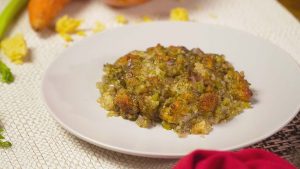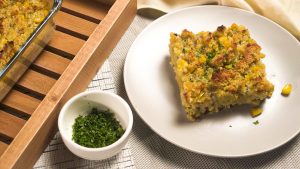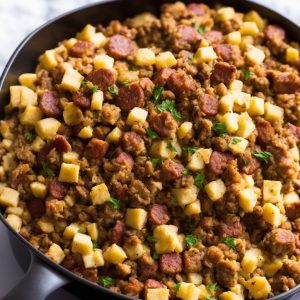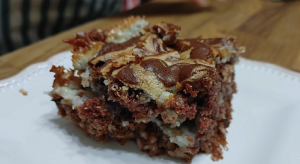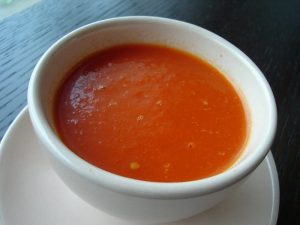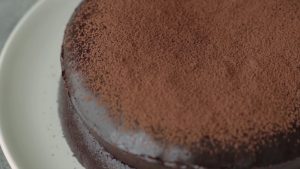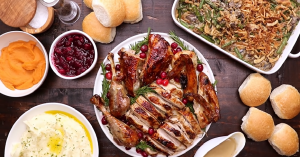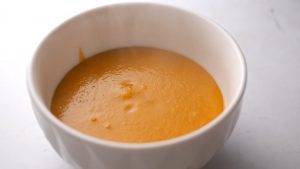This herb sausage stuffing is a savory, delectable side dish that complements any main course perfectly. The combination of hearty sausage, aromatic herbs, crunchy bread cubes, and sweet dried cranberries creates a symphony of flavors that truly captivates the palate. It's an excellent choice for family dinners, holiday feasts, and any occasion that calls for comfort food at its finest.
While most of the ingredients in this recipe are commonly found in most kitchens, there are a few you may need to hunt for at the supermarket. Sage pork sausage is a key component of this recipe, lending a mouthwatering savory bite. If unable to find it, you may substitute with regular pork sausage and add more sage. Flat-leaf parsley, fresh sage, and rosemary are also essential for that herby punch. Dried cranberries add a hint of sweetness and can be found in the dried fruit section.
Essential Ingredients for Herb Sausage Stuffing
Bread: Toasted to enhance its crunchiness and ability to absorb the flavorful stock.
Oil: Used to brown the sausage, aiding in its flavor development.
Sage pork sausage: The star of the dish, it adds a hearty, savory bite.
Unsalted butter: Adds richness and helps sauté the vegetables.
Onions and celery: Sautéed to a tender consistency, they add a savory backbone to the stuffing.
Garlic: Gives a touch of aromatic pungency.
Flat-leaf parsley, sage, and rosemary: Fresh herbs that lend an aromatic nuance.
Salt and pepper: Enhances the overall flavor of the stuffing.
Dry white wine: Adds a touch of acidity and depth.
Low sodium chicken stock: The liquid base that moistens the bread and carries flavor.
Egg: Helps bind the stuffing together.
Dried cranberries: Adds a sweet-tart contrast to the savory elements.
One reader, Felicdad Morley says:





This herb sausage stuffing recipe is a game-changer! The blend of savory sausage, aromatic herbs, and sweet cranberries creates a symphony of flavors. It's a hit at every gathering, and the aroma alone is enough to make mouths water. It's a must-try for anyone who loves a delicious, comforting dish.
Key Techniques for Making Herb Sausage Stuffing Recipe
How to prepare the bread cubes: Place the bread cubes in a single layer on a sheet pan and bake for 7 to 10 minutes at 350 degrees F, or until dried and toasted. Transfer the bread cubes to a very large bowl.
How to cook the sausage: In a large sauté pan, heat the oil over medium heat. Cook the sausages over medium heat for about 10 minutes, until browned and cooked through, breaking up the sausage with a fork while cooking. Add to the bread cubes.
How to sauté the vegetables: In the same pan, melt the butter and add the onions, celery, garlic, parsley, sage, rosemary, salt, and pepper. Sauté over medium heat for 10 minutes, until the vegetables are softened.
How to incorporate the stock and egg: Add the wine if using and allow the wine to reduce down to half for about 4 minutes. Take off the heat and mix in the stock to combine all of the flavors. Add the beaten egg and cranberries, and pour into the bread, mixing really well with a wooden spoon until all the liquid has been absorbed.
How to bake the stuffing: Pour the bread stuffing into a 9x12-inch baking dish. Bake for 30 minutes at 350 degrees F, until browned on top and hot in the middle. Serve warm.
How To Make Sausage Herb Stuffing
This sausage herb stuffing makes a filling and satisfying meal for dinner with flavorful spices and herbs sautéed in butter then baked in a delicious stock.
Serves:
Ingredients
- 16ozbread,cut into 1-inch pieces
- 1tbspoil
- 1lbsage pork sausage,or sweet or spicy Italian sausage, casings removed
- ⅓cupunsalted butter
- 1½cuponions,yellow or brown, finely chopped
- 1cupcelery,chopped
- 5garlic cloves,or 1 1/2 tablespoons minced garlic
- ½cupflat-leaf parsley,chopped
- 1½tbspfresh chopped sage
- 1tbspfresh chopped rosemary
- ¾tspsea salt,or more to taste
- ½tspfreshly ground black pepper
- ½cupdry white wine,optional
- 3cupslow sodium chicken stock
- 1egg,lightly whisked
- ¾cupdried cranberries,optional
Instructions
-
Preheat the oven to 350 degrees F.
-
Place the bread cubes in a single layer on a sheet pan and bake for 7 to 10 minutes, or until dried and toasted. Transfer the bread cubes to a very large bowl.
-
Meanwhile, in a large saute pan, heat the oil over medium heat. Cook the sausages over medium heat for about 10 minutes, until browned and cooked through, breaking up the sausage with a fork while cooking. Add to the bread cubes.
-
In the same pan, melt the butter and add the onions, celery, garlic, parsley, sage, rosemary, or thyme, salt, and pepper. Saute over medium heat for 10 minutes, until the vegetables are softened.
-
Add the wine if using and allow the wine to reduce down to half for about 4 minutes.
-
Take off the heat and mix in the stock to combine all of the flavors. Add the beaten egg and cranberries, and pour into the bread, mixing really well with a wooden spoon until all the liquid has been absorbed.
-
Pour the bread stuffing into a 9×12-inch baking dish. Bake for 30 minutes, until browned on top and hot in the middle. Serve warm.
Nutrition
- Calories: 392.05kcal
- Fat: 21.45g
- Saturated Fat: 8.18g
- Trans Fat: 0.31g
- Monounsaturated Fat: 7.64g
- Polyunsaturated Fat: 3.62g
- Carbohydrates: 35.26g
- Fiber: 3.57g
- Sugar: 10.45g
- Protein: 14.56g
- Cholesterol: 64.02mg
- Sodium: 606.66mg
- Calcium: 110.32mg
- Potassium: 400.63mg
- Iron: 3.00mg
- Vitamin A: 89.55µg
- Vitamin C: 7.08mg
Crucial Technique Tip for Herb Sausage Stuffing Recipe
When preparing your sage pork sausage, ensure to break it up into small pieces while it's cooking. This will allow it to mix more evenly with the bread cubes and other ingredients, resulting in a more balanced flavor in every bite of your stuffing. Additionally, when adding the chicken stock, make sure to pour it in gradually and stir consistently. This will help the bread to absorb the liquid evenly, preventing any dry spots in your stuffing.
Time-Saving Tips for Preparing This Recipe
Prep ahead: Prepare the bread cubes, chop the vegetables, and cook the sausage the day before to save time on the day of cooking.
Use a food processor: Use a food processor to quickly chop the onions, celery, and garlic for the stuffing, saving time on prep work.
Multi-task: While the bread cubes are toasting in the oven, use that time to cook the sausage and prepare the vegetable mixture to maximize efficiency.
Delegate: Enlist the help of family or friends to assist with the prep work, such as chopping vegetables or assembling the stuffing, to save time and make the process more enjoyable.
Organize ingredients: Before starting the recipe, gather and organize all the ingredients and equipment needed to streamline the cooking process.
Substitute Ingredients For Sausage Herb Stuffing Recipe
sage pork sausage - Substitute with vegetarian sausage: This substitution is suitable for vegetarians or those looking for a meat-free alternative. Vegetarian sausage can provide a similar texture and flavor to traditional pork sausage in the stuffing.
unsalted butter - Substitute with olive oil: Olive oil can be used as a healthier alternative to butter, and it adds a pleasant flavor to the stuffing.
onions - Substitute with shallots: Shallots have a milder and slightly sweeter flavor compared to onions, which can add a unique taste to the stuffing.
celery - Substitute with fennel: Fennel can provide a similar crunchy texture and a hint of anise flavor, which can complement the other ingredients in the stuffing.
garlic cloves - Substitute with garlic powder: Garlic powder can be used as a convenient substitute for fresh garlic cloves, providing a consistent flavor throughout the stuffing.
flat-leaf parsley - Substitute with cilantro: Cilantro can add a fresh and vibrant flavor to the stuffing, providing a unique twist to the traditional herb combination.
fresh chopped sage - Substitute with fresh chopped thyme: Thyme can offer a slightly earthy and floral flavor, which can complement the other herbs and add depth to the stuffing.
fresh chopped rosemary - Substitute with fresh chopped marjoram: Marjoram has a similar aromatic and slightly sweet flavor to rosemary, making it a suitable substitute in the stuffing.
sea salt - Substitute with kosher salt: Kosher salt can be used as a substitute for sea salt, providing a similar level of salinity to the stuffing.
freshly ground black pepper - Substitute with white pepper: White pepper can be used as a milder alternative to black pepper, providing a subtle heat and flavor to the stuffing.
dry white wine - Substitute with chicken or vegetable broth: Chicken or vegetable broth can be used as a non-alcoholic substitute for white wine, adding depth of flavor to the stuffing.
low sodium chicken stock - Substitute with vegetable stock: Vegetable stock can be used as a vegetarian-friendly alternative to chicken stock, providing a rich base for the stuffing.
egg - Substitute with flaxseed meal: Flaxseed meal can be used as a vegan-friendly substitute for eggs, acting as a binding agent in the stuffing.
dried cranberries - Substitute with dried cherries: Dried cherries can be used as an alternative to cranberries, providing a slightly different sweet and tart flavor to the stuffing.
Presentation Ideas for Herb Sausage Stuffing
Elevate the plating: When presenting the herb sausage stuffing, focus on creating an elegant and refined plating. Use fresh herbs and edible flowers to add a pop of color and freshness to the dish. Arrange the stuffing in a neat and visually appealing manner on the plate to showcase the textures and ingredients.
Incorporate texture: Add a textural element to the presentation by incorporating a crispy element, such as crispy sage leaves or toasted walnuts. This will not only enhance the visual appeal but also provide a delightful contrast in texture to the dish.
Utilize unique serving vessels: Consider serving the herb sausage stuffing in individual mini cast iron skillets or pumpkin-shaped bowls to add a touch of creativity and whimsy to the presentation. This unexpected presentation will captivate the judges and elevate the overall dining experience.
Garnish with precision: Pay attention to the finer details by garnishing the dish with meticulously placed microgreens or delicate pumpkin seed brittle. The precision in garnishing will demonstrate your attention to detail and dedication to the art of culinary presentation.
Create a harmonious composition: Focus on creating a visually balanced composition on the plate. Arrange the herb sausage stuffing alongside complementary elements such as roasted root vegetables or butternut squash puree to create a harmonious and visually stunning presentation.
Incorporate seasonal elements: Embrace the season by incorporating seasonal elements into the presentation. Consider using fall foliage or miniature pumpkins and gourds as part of the plating to evoke a sense of seasonal charm and warmth.
Attention to plate cleanliness: Prioritize plate cleanliness and ensure that each element of the presentation is meticulously placed with care. Wipe the edges of the plate to remove any smudges and ensure a pristine presentation that reflects professionalism and attention to detail.
Balance flavors and colors: Aim for a balanced presentation by incorporating a variety of colors and flavors. Consider adding a vibrant pomegranate arils or a drizzle of balsamic reduction to add both visual interest and a burst of complementary flavors to the dish.
Essential Kitchen Tools for Making Herb Sausage Stuffing
- Sheet pan: A flat, rectangular metal pan used for baking and roasting.
- Large saute pan: A wide, shallow pan with straight sides, used for sautéing, frying, and searing foods.
- Wooden spoon: A cooking utensil with a long handle and a rounded head, often used for stirring and mixing ingredients.
- Baking dish: A deep, oven-safe dish used for baking and roasting dishes such as casseroles and gratins.
- Food processor: A kitchen appliance used for chopping, slicing, and pureeing ingredients.
- Mixing bowl: A deep bowl used for mixing and combining ingredients.
Storage and Freezing Instructions for Herb Sausage Stuffing
- Let the stuffing cool completely before storing or freezing.
- To store in the fridge, place the cooled stuffing in an airtight container and refrigerate for up to 4 days.
- To freeze, transfer the cooled stuffing to a freezer-safe container or resealable plastic bag. Remove as much air as possible before sealing to prevent freezer burn.
- Label the container or bag with the date and contents for easy identification.
- Freeze the stuffing for up to 3 months for best quality.
- To reheat frozen stuffing, thaw it overnight in the refrigerator.
- Place the thawed stuffing in a baking dish and cover with foil. Bake in a preheated 350°F (175°C) oven for about 20-30 minutes, or until heated through.
- Alternatively, you can reheat smaller portions of stuffing in the microwave. Place the desired amount in a microwave-safe dish, cover with a damp paper towel, and microwave on high for 1-2 minutes, or until heated through. Stir occasionally to ensure even heating.
- For best results, add a splash of chicken broth or water to the stuffing before reheating to help maintain moisture and prevent dryness.
- Enjoy your reheated herb sausage stuffing as a delicious side dish or use it to stuff poultry, pork chops, or bell peppers for a flavorful meal.
How To Reheat Leftover Herb Sausage Stuffing
Preheat your oven to 350°F (175°C). Transfer the leftover herb sausage stuffing to an oven-safe dish and cover it with aluminum foil. Bake for about 20-25 minutes, or until the stuffing is heated through. Remove the foil during the last 5 minutes of baking to crisp up the top.
For a quicker method, reheat individual portions of stuffing in the microwave. Place a serving of stuffing on a microwave-safe plate and cover it with a damp paper towel. Microwave on high for 1-2 minutes, or until the stuffing is heated through. The damp paper towel will help prevent the stuffing from drying out.
If you have a bit more time, reheat the stuffing in a skillet on the stovetop. Melt a small amount of butter in a skillet over medium heat. Add the leftover stuffing and stir occasionally, breaking up any large clumps. Cook for 5-7 minutes, or until the stuffing is heated through and slightly crispy on the outside.
For a unique twist, transform your leftover stuffing into stuffing cakes. Mix the stuffing with a beaten egg to help bind it together. Form the mixture into small patties and fry them in a skillet with a little olive oil or butter until golden brown and crispy on both sides.
If your stuffing seems a bit dry after reheating, drizzle some warm chicken broth or turkey stock over it to help moisten it back up. This will also add an extra layer of flavor to the dish.
Interesting Trivia About Herb Sausage Stuffing
The herb sausage stuffing recipe is a classic dish often enjoyed during Thanksgiving and other holiday gatherings. It is a versatile dish that can be customized with different herbs and spices to suit individual tastes. This flavorful stuffing is a great way to use up leftover bread and pairs well with roasted meats or poultry. It's a delicious way to add a savory element to any meal.
Is Making Herb Sausage Stuffing at Home Cost-Effective?
This herb sausage stuffing recipe is quite cost-effective for a household. The ingredients, such as pork sausage, bread, and vegetables, are commonly found and reasonably priced. The dish is hearty and can serve as a main course or a side dish, making it versatile for different meals. The estimated cost for a household of 4 people is approximately $20-$25, making it an affordable option for a satisfying and flavorful meal. Overall Verdict: 9/10
Is This Stuffing Recipe Healthy or Not?
This herb sausage stuffing recipe, while undeniably delicious, leans more towards the unhealthy side due to several factors:
- The use of high-fat ingredients like pork sausage and butter contributes to the overall calorie and saturated fat content.
- White bread, which is typically used for stuffing, is made from refined flour and lacks the fiber and nutrients found in whole grain bread.
- The recipe calls for a significant amount of salt, which can be a concern for those watching their sodium intake.
However, the inclusion of vegetables like onions, celery, and garlic, as well as the use of fresh herbs, does add some nutritional value to the dish.
To make this stuffing recipe healthier without compromising on flavor, consider the following modifications:
- Opt for a leaner protein source, such as turkey or chicken sausage, or even a plant-based alternative to reduce the saturated fat content.
- Replace some or all of the white bread with whole grain bread to increase the fiber and nutrient content.
- Reduce the amount of butter used, or substitute a portion of it with heart-healthy olive oil.
- Be mindful of the salt content and consider reducing the amount added, as the sausage and stock may already contain significant amounts of sodium.
- Increase the proportion of vegetables in the recipe to boost the fiber and nutrient content further. Consider adding additional vegetables like mushrooms, carrots, or bell peppers.
- Experiment with using a mixture of dried and fresh herbs to enhance the flavor without relying on excessive salt.
Editor's Opinion on This Herb Sausage Stuffing Recipe
The herb sausage stuffing recipe is a delightful combination of savory flavors and textures. The use of sage pork sausage, fresh herbs, and dried cranberries creates a harmonious blend of sweet and savory notes. The addition of white wine adds depth to the dish, while toasting the bread cubes beforehand provides a satisfying crunch. The recipe's balance of ingredients and cooking techniques results in a delicious stuffing that would complement a variety of main dishes.
Enhance Your Sausage Herb Stuffing Recipe with These Unique Side Dishes:
Similar Recipes to Try Instead of Herb Sausage Stuffing
Appetizer and Dessert Pairings for Herb Sausage Stuffing Recipe
Why trust this Sausage Herb Stuffing Recipe:
This recipe offers a perfect balance of flavors and textures, ensuring a delicious and satisfying dish. The combination of sage pork sausage, fresh herbs, and dried cranberries creates a harmonious blend of savory and sweet notes. The use of dry white wine adds depth and complexity to the dish, while the toasting of the bread cubes enhances the overall texture. With the careful incorporation of low sodium chicken stock and the addition of an egg, this recipe promises a moist and flavorful stuffing that will surely impress your guests.
Was this page helpful?
Have your own special recipe to share? Submit Your Recipe Today!



